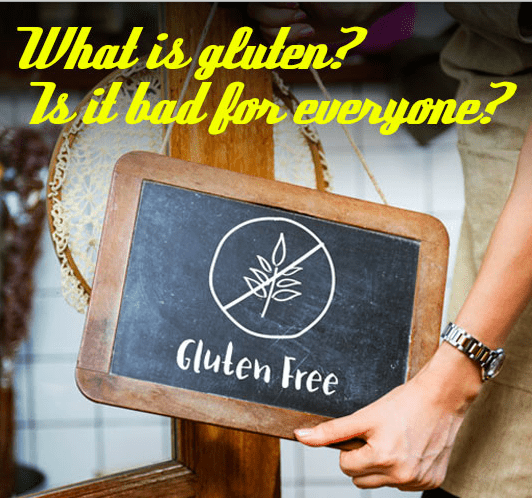As we begin 2020, we can choose to be more focused on the quality as well as the quantity of the types of foods we consume. Just decades ago people were often misinformed about many common foods, their ingredients and how they could possibly affect overall health and undiagnosed conditions.
One commonly discussed topic is gluten, which is a collective of proteins found in grains, including wheat, rye and barley. Now, knowing that gluten is in so many foods, and the effects it may have on us, can put each of us at a distinct advantage over those who previously did not have access to this knowledge. Although the effects of gluten vary, it’s important to understand what gluten is, and who truly needs to restrict gluten or maintain a gluten-free diet vs. those who simply can avoid gluten at their own discretion.
What is gluten?
 Gluten is a family of proteins found in rye, wheat, barley and triticale. There are many types of wheat which include wheat berries, farina, farro and semolina, to name just a few. Gluten is an integral part of food as it helps maintain their shape, basically acting as a bonding element to hold them together. Gluten is found in cereal, bread, pasta, beer, soups, cosmetics and many other commonly found food and products that people consume daily. While gluten is naturally occurring, it sometimes doesn’t digest well. This can cause inflammation of the intestinal lining that can lead to leaky gut syndrome, which occurs when foreign substances and toxins leak into our bodies. This can cause activation of our immune system and inflammation which in some instances can be so severe that the body actually attacks itself.
Gluten is a family of proteins found in rye, wheat, barley and triticale. There are many types of wheat which include wheat berries, farina, farro and semolina, to name just a few. Gluten is an integral part of food as it helps maintain their shape, basically acting as a bonding element to hold them together. Gluten is found in cereal, bread, pasta, beer, soups, cosmetics and many other commonly found food and products that people consume daily. While gluten is naturally occurring, it sometimes doesn’t digest well. This can cause inflammation of the intestinal lining that can lead to leaky gut syndrome, which occurs when foreign substances and toxins leak into our bodies. This can cause activation of our immune system and inflammation which in some instances can be so severe that the body actually attacks itself.
What is gluten intolerance?
Gluten intolerance, like most other food intolerances, causes undesirable symptoms usually related to digestion when gluten is consumed. With a food allergy, the body’s immune system overreacts to certain foods causing symptoms that range from a simple rash to respiratory distress that can be life threatening. Gluten intolerance should not be confused with Celiac Disease, an autoimmune disorder involving the small intestine. Celiac Disease can be associated with a variety of GI symptoms such as diarrhea, constipation, gas, abdominal pain and bloating, but may also be associated with fatigue, anemia, joint pain, rash and depression. Those with celiac disease should avoid gluten at all costs.
Symptoms of general gluten intolerance may include gassiness, abdominal pain or diarrhea. Some of these symptoms are very similar to other food intolerances such as lactose intolerance, so many people have to go through a process of food elimination to determine the specific intolerance or condition. Symptoms of celiac disease are much more extreme and may be life-altering, and may include diarrhea, bloating, gas, fatigue, weight loss, anemia, depression, joint pain and rashes. In general, it is recommended to consult with a doctor if there are any concerns about food allergies or intolerances or potentially the presence of celiac disease.
Gluten alternatives for a gluten-free lifestyle
 For anyone coping with gluten intolerance or simply just interested in avoiding gluten for the sake of general wellness, it is good to be aware of the alternatives to make the transition easy. A gluten free diet usually starts with avoiding the big 3 (rye, wheat and barley) and learning more about the foods that do not include gluten or those that are made without it. Other foods to check before purchasing, or to avoid altogether, include pasta, cakes, pies, beer, cookies, dressings and many sauces including soy sauce.
For anyone coping with gluten intolerance or simply just interested in avoiding gluten for the sake of general wellness, it is good to be aware of the alternatives to make the transition easy. A gluten free diet usually starts with avoiding the big 3 (rye, wheat and barley) and learning more about the foods that do not include gluten or those that are made without it. Other foods to check before purchasing, or to avoid altogether, include pasta, cakes, pies, beer, cookies, dressings and many sauces including soy sauce.
Typically, in a grocery store a small section may be dedicated to being gluten-free or you can simply look on the package to confirm if they are advertising the product as being gluten-free. Regardless, tools such as Google can help you research and confirm by product. As an alternative to the big 3 that contain gluten, there are options such as quinoa, brown rice, wild rice, buckwheat, sorghum, tapioca, millet amaranth, arrowroot oats and gluten-free bread. It should be noted that even though a food is gluten free it still may be high in carbohydrates that are limited in many weight loss programs. Other common items that are usually gluten-free include dairy, fruits, vegetables, nuts, healthy fats and herbs/spices.
For those that love to eat out, most restaurants are required to keep master guides on all recipes so you can ask a server or manager about gluten-free options. To make things convenient, restaurants may advertise gluten free options on their menus to save time and ensure that those with intolerances, celiac disease and the general gluten-free preference have easy options.
For inspiration and answers to questions you may have about leading a healthy lifestyle and different types of supplements, read previous blogs by CardioMender, MD Weight Loss Specialists at https://www.cardiomenderweightloss.com/blog/
References:
https://www.healthline.com/nutrition/gluten-free-foods#1 (Healthline: 54 Foods You Can Eat on a Gluten-Free Diet)
https://celiac.org/gluten-free-living/what-is-gluten/ (Celiac Disease Foundation: What is gluten?)
https://www.medicalnewstoday.com/articles/288406.php (Medical News Today: Is a gluten-free diet good for your health?)
https://www.aaaai.org/conditions-and-treatments/conditions-dictionary/gluten-intolerance (American academy of asthma allergy and immunology: Gluten Intolerance Definition)
https://www.healthline.com/nutrition/celiac-disease-symptoms (Healthline: 9 Signs and Symptoms of Celiac Disease)
https://gluten.org/2019/12/16/the-gluten-free-diet-facts-and-myths/ (Gluten Intolerance Group: Facts and Myths)



